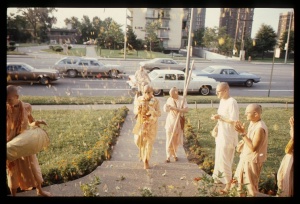CC Adi 8.73 (1975): Difference between revisions
(Vanibot #0027: CCMirror - Mirror CC's 1996 edition to form a basis for 1975) |
(Vanibot #0020: VersionCompareLinker - added a link to the Version Compare feature) |
||
| Line 2: | Line 2: | ||
<div style="float:left">'''[[Sri Caitanya-caritamrta (1975)|Śrī Caitanya-caritāmṛta (1975)]] - [[CC Adi (1975)|Ādi-līlā]] - [[CC Adi 8 (1975)|Chapter 8: The Author Receives the Orders of Kṛṣṇa and Guru]]'''</div> | <div style="float:left">'''[[Sri Caitanya-caritamrta (1975)|Śrī Caitanya-caritāmṛta (1975)]] - [[CC Adi (1975)|Ādi-līlā]] - [[CC Adi 8 (1975)|Chapter 8: The Author Receives the Orders of Kṛṣṇa and Guru]]'''</div> | ||
<div style="float:right">[[File:Go-previous.png|link=CC Adi 8.72 (1975)|Ādi-līlā 8.72]] '''[[CC Adi 8.72 (1975)|Ādi-līlā 8.72]] - [[CC Adi 8.74 (1975)|Ādi-līlā 8.74]]''' [[File:Go-next.png|link=CC Adi 8.74 (1975)|Ādi-līlā 8.74]]</div> | <div style="float:right">[[File:Go-previous.png|link=CC Adi 8.72 (1975)|Ādi-līlā 8.72]] '''[[CC Adi 8.72 (1975)|Ādi-līlā 8.72]] - [[CC Adi 8.74 (1975)|Ādi-līlā 8.74]]''' [[File:Go-next.png|link=CC Adi 8.74 (1975)|Ādi-līlā 8.74]]</div> | ||
{{CompareVersions|CC|Adi 8.73|CC 1975|CC 1996}} | |||
{{RandomImage}} | {{RandomImage}} | ||
==== TEXT 73 ==== | ==== TEXT 73 ==== | ||
| Line 32: | Line 31: | ||
<div class="purport"> | <div class="purport"> | ||
A Vaiṣṇava always follows the order of guru and Kṛṣṇa. Śrī Caitanya-caritāmṛta was written by Kṛṣṇadāsa Kavirāja Gosvāmī by their mercy. Kṛṣṇadāsa Kavirāja Gosvāmī considered all the devotees that have been mentioned to be his preceptor gurus, or spiritual masters, and Madana-gopāla (Śrī Madana-mohana vigraha) is Kṛṣṇa Himself. Thus he took permission from both of them, and when he received the mercy of both guru and Kṛṣṇa, he was able to write this great literature, Śrī Caitanya-caritāmṛta. This example should be followed. Anyone who attempts to write about Kṛṣṇa must first take permission from the spiritual master and Kṛṣṇa. Kṛṣṇa is situated in | A Vaiṣṇava always follows the order of guru and Kṛṣṇa. Śrī Caitanya-caritāmṛta was written by Kṛṣṇadāsa Kavirāja Gosvāmī by their mercy. Kṛṣṇadāsa Kavirāja Gosvāmī considered all the devotees that have been mentioned to be his preceptor gurus, or spiritual masters, and Madana-gopāla (Śrī Madana-mohana vigraha) is Kṛṣṇa Himself. Thus he took permission from both of them, and when he received the mercy of both guru and Kṛṣṇa, he was able to write this great literature, Śrī Caitanya-caritāmṛta. This example should be followed. Anyone who attempts to write about Kṛṣṇa must first take permission from the spiritual master and Kṛṣṇa. Kṛṣṇa is situated in everyone's heart, and the spiritual master is His direct external representative. Thus Kṛṣṇa is situated antar-bahiḥ, within and without. One must first become a pure devotee by following the strict regulative principles and chanting sixteen rounds daily, and when one thinks that he is actually on the Vaiṣṇava platform, he must then take permission from the spiritual master, and that permission must also be confirmed by Kṛṣṇa from within his heart. Then, if one is very sincere and pure, he can write transcendental literature, either prose or poetry. | ||
</div> | </div> | ||
Latest revision as of 19:49, 26 January 2020

A.C. Bhaktivedanta Swami Prabhupada
TEXT 73
- vaiṣṇavera ājñā pāñā cintita-antare
- madana-gopāle gelāṅ ājñā māgibāre
SYNONYMS
vaiṣṇavera—of all the Vaiṣṇava devotees; ājñā—order; pāñā—receiving; cintita-antare—anxiety within myself; madana-gopāle—to the temple of Śrī Madana-mohana; gelāṅ—I went; ājñā—order; māgibāre—to receive.
TRANSLATION
Having received the order of the Vaiṣṇavas but being anxious within my heart, I went to the temple of Madana-mohana in Vṛndāvana to ask His permission also.
PURPORT
A Vaiṣṇava always follows the order of guru and Kṛṣṇa. Śrī Caitanya-caritāmṛta was written by Kṛṣṇadāsa Kavirāja Gosvāmī by their mercy. Kṛṣṇadāsa Kavirāja Gosvāmī considered all the devotees that have been mentioned to be his preceptor gurus, or spiritual masters, and Madana-gopāla (Śrī Madana-mohana vigraha) is Kṛṣṇa Himself. Thus he took permission from both of them, and when he received the mercy of both guru and Kṛṣṇa, he was able to write this great literature, Śrī Caitanya-caritāmṛta. This example should be followed. Anyone who attempts to write about Kṛṣṇa must first take permission from the spiritual master and Kṛṣṇa. Kṛṣṇa is situated in everyone's heart, and the spiritual master is His direct external representative. Thus Kṛṣṇa is situated antar-bahiḥ, within and without. One must first become a pure devotee by following the strict regulative principles and chanting sixteen rounds daily, and when one thinks that he is actually on the Vaiṣṇava platform, he must then take permission from the spiritual master, and that permission must also be confirmed by Kṛṣṇa from within his heart. Then, if one is very sincere and pure, he can write transcendental literature, either prose or poetry.